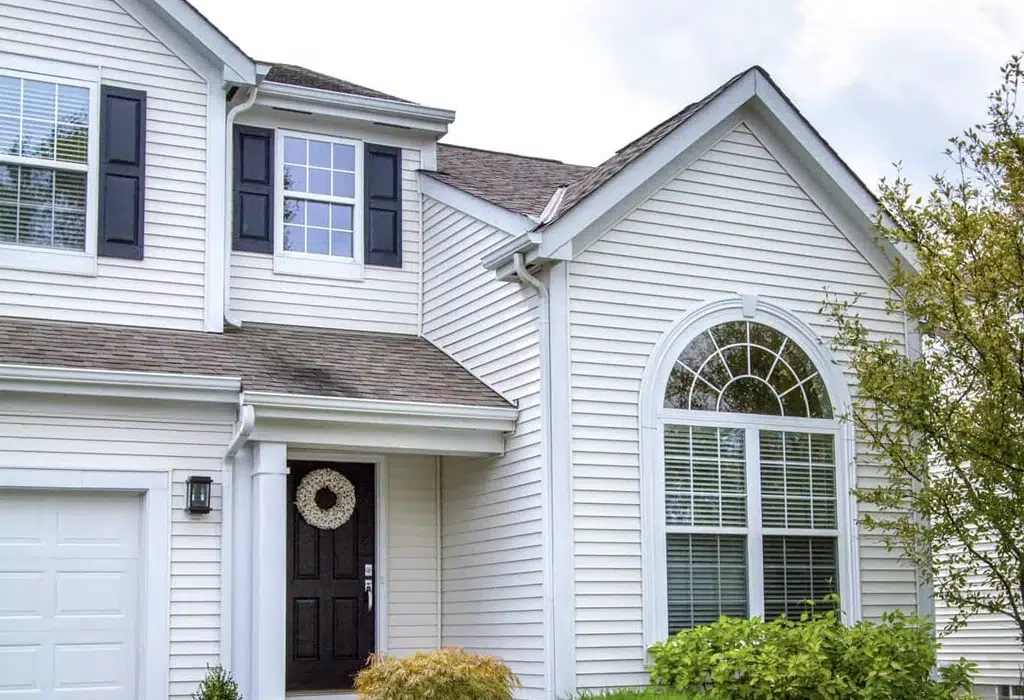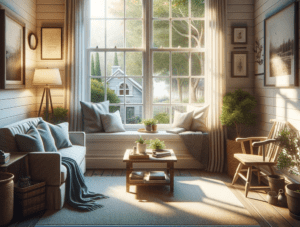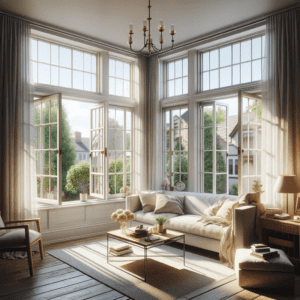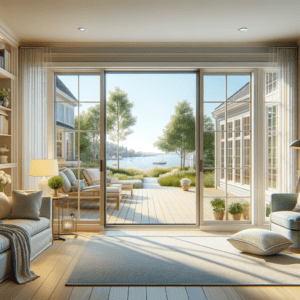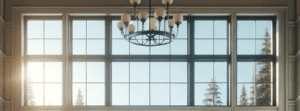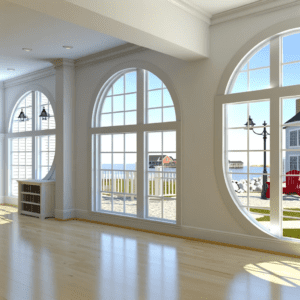Whether you are building a new home or upgrading your existing one, understanding the different types of windows available, along with their features and benefits, can guide you in making an informed decision.
Understanding your home’s specific needs is crucial when selecting the perfect window type. The right windows will enhance energy efficiency while complementing your home’s aesthetics. In this article, we will explore the various types of windows suitable for Maryland homes, including their materials, styles, and glazing options. We will also delve into important considerations such as energy efficiency ratings, maintenance requirements, and local factors that can influence your window selection process.

Common Types of Windows Used in Maryland Homes
Maryland homes feature a variety of window types to suit different architectural styles, climates, and personal preferences. Here are some of the most common window types found in Maryland residences, each offering unique benefits and functionalities that we will explore throughout this article:
- Single and Double-Hung Windows
- Casement Windows
- Sliding/Gliding Windows
- Awning Windows
- Bay and Bow Windows
- Picture Windows
- Shape Windows
- Specialty Windows For Energy-Efficiency, Impact Resistance, and Soundproofing
Single and Double-Hung Windows
Single and double-hung windows are among the most traditional and popular window styles found in American homes, including those in Maryland. Both types consist of sashes (the movable parts of the window) and frames. In a single-hung window, only the bottom sash is operable, meaning it can move up and down, while the top sash remains stationary. In contrast, a double-hung window allows both the top and bottom sashes to move, providing greater flexibility in ventilation.
Pros:
- Ventilation: Double-hung windows offer excellent ventilation options, as you can open both the top and bottom sashes to create an airflow cycle in your home.
- Easy to clean: Many modern double-hung windows are designed so that the sashes can tilt inward, allowing you to clean the exterior glass from the inside of your home.
- Classic aesthetic: Both window types have a traditional appearance that complements a wide range of architectural styles, making them a versatile choice for Maryland homes.
Cons:
- Air leakage: Over time, the seals around sashes can wear out, especially in double-hung windows, leading to air leakage which can affect energy efficiency.
- Maintenance: Because of their multiple moving parts and traditional construction, these windows may require more maintenance than other types.
- Limited size: Generally, single and double-hung windows are not as large as other types, which may limit the amount of natural light and views of the outdoors.
These windows are best used in areas where you want to maintain a classic look, require good ventilation, or have limited exterior space, as they do not protrude outward. Bedrooms, living rooms, and kitchens in Maryland homes can benefit from the installation of single or double-hung windows. However, homeowners should consider energy-efficient models with tight seals and double or triple glazing to address potential air leakage issues and ensure that the windows can withstand Maryland’s varied climate throughout the year.
Casement Windows
Casement windows are characterized by their single sash that is hinged on the side and opens outward, much like a door. They are typically operated by a crank mechanism, making them easy to open and close, especially in hard-to-reach areas. This type of window provides a clear, unobstructed view when open and closed, thanks to the absence of a rail or meeting stile in the middle.
Pros:
- Excellent Ventilation: Casement windows can open fully, which allows for superior ventilation compared to other window types. This makes them ideal for the humid Maryland climate.
- Energy Efficiency: When closed, casement windows seal tightly against their frame, providing an effective barrier against air leakage, which can help reduce energy bills.
- Unobstructed Views: With no bars or rails to divide the window, casement windows offer clear views of the outdoors.
- Security: The design of casement windows makes them difficult to break into from the outside when properly locked.
Cons:
- Mechanical Parts: The crank mechanisms can wear out over time and may require maintenance or replacement.
- Safety Concerns: Because they open outward, casement windows can pose a safety risk in high-traffic areas outside the home, such as near sidewalks or decks.
- Wind Vulnerability: In areas with strong winds, open casement windows can catch the wind like a sail and may become damaged.
Casement windows are particularly well-suited for Maryland homes due to their excellent ventilation capabilities, which can help manage indoor humidity levels during the hot and muggy summer months. They are ideal for areas where maximizing air circulation is desired, such as kitchens, bathrooms, and bedrooms.
In terms of placement, casement windows are best used where there is no external obstruction, such as in areas overlooking patios, gardens, or the backyard. They are less suitable for areas where their outward-opening design could obstruct pathways or outdoor living spaces. For homeowners in Maryland looking to combine aesthetics, energy efficiency, and functionality, casement windows are an excellent choice that can cater to a wide range of needs and preferences.
Sliding/Gliding Windows
Sliding or gliding windows consist of one or more panels that move horizontally along upper and lower tracks. In most designs, one pane is stationary while the other slides open. However, in some versions, both panes can slide, allowing for greater flexibility in ventilation. The mechanics are straightforward: rollers or glides attached to the bottom of the window sash allow for smooth lateral movement, making these windows easy to operate with minimal effort.
These windows are characterized by their sleek, linear design, which can complement modern and traditional architecture alike. They are particularly well-suited for spaces where vertical space is limited, as they do not require any outward or upward clearance to open.
Pros:
- Space-saving: Since they open horizontally, sliding windows do not require additional space to operate, making them ideal for areas adjacent to patios, decks, or walkways.
- Easy Operation: Sliding windows glide smoothly along their tracks, making them easy to open and close, particularly suitable for the elderly or those with limited mobility.
- Natural Light: Their typically large panes allow for ample natural light and can offer expansive outdoor views.
- Ventilation: By opening either end (in double-sliding windows), you can create natural airflow and adjust ventilation according to your needs.
Cons:
- Cleaning: Sliding windows can be more challenging to clean from the inside, especially on higher floors, as the outside of the window cannot always be reached easily.
- Air Sealing: They might not seal as tightly as other window types, such as casement windows, which can lead to higher air leakage rates.
- Track Maintenance: The tracks need regular cleaning and maintenance to ensure smooth operation and prevent dirt, debris, or corrosion from impairing the window’s movement.
Sliding windows are a versatile option for Maryland homes, fitting well with both contemporary and traditional designs. They are particularly effective in rooms that face walkways, gardens, or other areas where conserving exterior space is crucial. Given their ability to provide significant natural light, they are excellent for living rooms, bedrooms, and kitchens where daylight can enhance the environment and reduce the need for artificial lighting.
Awning Windows
Awning windows are hinged at the top and open outward from the bottom, creating an awning-like effect. This unique design allows them to be opened slightly for ventilation without letting in rain or falling leaves, which makes them especially useful during varied weather conditions. They are typically operated with a crank, sliding, or push-out mechanism, allowing for easy use and providing a secure, tight closure when needed.
The mechanics of awning windows ensure that the window seals tightly against the frame when closed, improving thermal efficiency. This sealing capability is enhanced by the fact that the weight of the sash presses against the frame, creating an effective barrier against outdoor elements.
Pros:
- Ventilation: Awning windows can be left open during a rainstorm without letting water into the home, providing excellent ventilation regardless of weather conditions.
- Energy Efficiency: They often come with tight seals that improve energy efficiency by reducing air leakage.
- Placement Versatility: They can be placed higher on walls than many other types of windows, which allows for natural light and ventilation while maintaining privacy.
- Security: The design and opening mechanism make them more difficult for intruders to enter through the window.
Cons:
- Obstruction: Because they open outward, they can obstruct outdoor spaces like walkways or patios.
- Cleaning: Cleaning the exterior of awning windows from inside the house can be challenging, especially on upper floors.
- Size Limitations: They are typically smaller than other window types, which may limit the amount of natural light they can provide.
Overall, awning windows are a versatile, energy-efficient option suitable for various areas within Maryland homes, enhancing comfort, safety, and the overall living environment. Their ability to provide ventilation without letting in rain makes them particularly beneficial for areas like bathrooms and kitchens, where humidity control is essential. They are also a good choice for hard-to-reach areas, where their easy-to-operate mechanisms make them practical and convenient.
Bay and Bow Windows
Bay and bow windows are architectural features that project outward from the main walls of a house, creating a bay or alcove in the room. Bay windows typically consist of three windows: a large central window flanked by two smaller windows at angles, usually 30 or 45 degrees to the wall. Bow windows, on the other hand, consist of four or more windows joined together to form a gentle outward curve, providing a rounded appearance from the outside.
The mechanics of bay and bow windows involve a supportive structure that extends from the exterior wall, requiring careful installation to ensure they are structurally sound and properly sealed against the elements. The side windows of a bay setup (and all windows of a bow setup) can often be opened, providing ventilation, while the central windows are usually fixed.
Pros:
- Aesthetic Appeal: Bay and bow windows add architectural interest and aesthetic value to any home, enhancing curb appeal.
- Increased Space: The design creates additional floor space and can be used as a cozy reading nook, storage, or even a small seating area.
- Natural Light: These windows allow for more natural light to enter the room from multiple directions.
- Enhanced Views: The angular and rounded designs provide panoramic views of the outdoors, making them ideal for homes with scenic surroundings.
Cons:
- Cost: Bay and bow windows are typically more expensive than standard windows due to their size and the complexity of installation.
- Maintenance: The structure and sealing of these windows can require more maintenance, especially in climates with extreme weather.
- Installation Complexity: Proper installation is crucial to avoid structural issues, and finding the right space on the home’s exterior can be challenging.
Bay and bow windows are well-suited to Maryland homes, particularly those with beautiful outdoor scenery, such as waterfront properties, homes in rural areas, or houses with well-landscaped gardens. They can add character and charm to colonial and traditional homes, which are common in the region.
In terms of specific rooms, these windows are best placed in living rooms, dining rooms, or master bedrooms where the added space, light, and views can be fully appreciated. They can transform a simple room into a bright, inviting space, making it appear larger and more welcoming.
While bay and bow windows represent a more significant financial investment than other types, their unique benefits can greatly enhance the living experience and value of a Maryland home. Their ability to blend with various architectural styles, along with their practical advantages, makes them a popular choice among Maryland homeowners.
Picture Windows
Picture windows are large, fixed-pane windows that provide an unobstructed view of the outdoors, much like a picture frame. These windows do not open or close and are designed primarily to maximize natural light and offer expansive views. Due to their simplicity, picture windows have fewer mechanical parts, which reduces the potential for maintenance issues over time. The window must be properly sealed and insulated around the edges to prevent air leaks and improve energy efficiency, particularly important in Maryland’s varying climate.
Pros:
- Unobstructed Views: Picture windows offer clear, panoramic views of the outside, making them perfect for showcasing Maryland’s landscapes or cityscapes.
- Natural Light: They allow for a significant amount of natural light to enter the room, which can enhance the mood and reduce the need for artificial lighting.
- Energy Efficiency: Since they do not open, picture windows can be more energy-efficient than operable windows, as there are no gaps for air to leak through.
- Low Maintenance: With no moving parts, picture windows require less maintenance compared to other types of windows.
Cons:
- Ventilation: Picture windows do not open, so they do not provide ventilation, which can be a drawback in rooms that require fresh air circulation.
- Escape Routes: In case of emergencies, they do not serve as escape routes.
- Cleaning: Large picture windows, especially those in hard-to-reach areas, can be challenging to clean from the outside.
- Cost: Large panes of glass can be expensive, especially if opting for energy-efficient or tempered glass.
Picture windows are best used in Maryland homes where maximizing views and natural light is a priority, such as in living rooms overlooking the Chesapeake Bay, rural landscapes, or suburban gardens. They are ideal for homes with high ceilings and large wall spaces where they can create dramatic focal points without the need for wall art.
Due to the lack of ventilation, picture windows are best paired with operable windows in areas that require air circulation, like bedrooms or kitchens. This combination can provide the aesthetic benefits of picture windows while still allowing for ventilation when needed.
Shape Windows
Shape windows, also known as specialty or custom-shaped windows, refer to windows that come in non-standard shapes and sizes. They can range from circular, oval, triangular, and hexagonal to more complex geometric forms. These windows are typically fixed (non-opening) and are used more for their aesthetic appeal and architectural interest than for functionality.
The mechanics of shape windows depend largely on their design and the materials used. They are usually framed in materials that can be easily molded or shaped, such as aluminum, vinyl, or fiberglass. However, the unique shapes require precise craftsmanship and installation to ensure a proper fit and to prevent leaks or drafts.
Pros:
- Aesthetic Appeal: Shape windows can add a unique architectural element to a home, enhancing its character and curb appeal.
- Natural Light: These windows can provide additional natural light to spaces that may not be suited for standard windows.
- Customization: They offer homeowners the chance to customize their living spaces according to their tastes and home’s architectural style.
- Energy Efficiency: Since most shape windows are fixed, they typically offer better insulation than operable windows, reducing air leakage.
Cons:
- Ventilation: Like picture windows, shape windows do not open, so they do not provide ventilation.
- Cleaning and Maintenance: Due to their unique shapes, these windows can be challenging to clean and maintain, especially if they are large or placed in hard-to-reach areas.
- Cost: Custom shapes and sizes can make these windows more expensive than standard windows, both in terms of the window itself and the installation costs.
- Limited Replacement Options: If a shape window needs to be replaced, it may be more difficult and expensive to find a suitable replacement than for standard window types.
Shape windows are best used in Maryland homes as an accent to standard windows, adding visual interest and complementing the home’s architectural style. They can be particularly effective in entryways, gables, or in rooms with vaulted ceilings where traditional windows might not fit or would look out of place. In homes with unique architectural features, such as Victorian, contemporary, or custom-built homes, shape windows can enhance these features and create focal points.
When considering shape windows for a Maryland home, it’s important to balance aesthetic desires with practical considerations like energy efficiency, placement, and cost. Homeowners should ensure that these specialty windows complement rather than detract from the overall design and functionality of their living spaces.

Specialty Windows for Maryland Homes
Maryland’s diverse climate and geography, from the Atlantic coastline to urban centers and rural landscapes, necessitate the consideration of specialty windows to address specific environmental and lifestyle needs. Energy-efficient, impact-resistant, and soundproof windows each offer unique benefits tailored to Maryland’s varied conditions and can significantly enhance the comfort, security, and energy efficiency of homes in the state.
Energy-Efficient Windows
Maryland experiences a range of weather conditions, from hot, humid summers to cold, snowy winters. Energy-efficient windows are crucial in this region for maintaining comfortable indoor temperatures year-round without over-reliance on heating and cooling systems. They help in reducing energy consumption and lowering utility bills, making them a wise investment for Maryland homeowners.
Features and Benefits:
- Double or Triple Pane Glass: Multiple layers of glass with air or gas (such as argon or krypton) fillings provide insulation, reducing heat transfer.
- Low-E Coatings: These microscopic, metallic coatings reflect infrared light, keeping heat inside during the winter and outside during the summer.
- Warm Edge Spacers and Improved Framing Materials: These reduce heat transfer and help prevent condensation and mold growth.
- Energy Star Ratings: Windows that meet or exceed Energy Star standards for the Mid-Atlantic region offer assurance of energy efficiency.
Impact-Resistant Windows
For homes in Maryland’s coastal areas, particularly those susceptible to hail and coastal tropical storms, impact-resistant windows are essential. They provide added safety and can prevent significant damage from high winds, flying debris, and even intruders.
Features and Benefits:
- Reinforced Glass: Typically made of laminated glass, consisting of a tough plastic interlayer sandwiched between two layers of glass, which holds together if shattered.
- Sturdy Frames: Often constructed from heavy-duty materials like aluminum, vinyl, or reinforced wood, which help to hold the glass in place during high winds.
- UV Protection: Many impact-resistant windows also offer protection against harmful UV rays, protecting interior furnishings from fading.
- Noise Reduction: The same characteristics that make them impact-resistant also help in reducing outside noise, making them beneficial for homes near busy areas.
Soundproof Windows
In Maryland’s urban areas, such as Baltimore and its suburbs, traffic, construction, and city noise can be a constant issue. Soundproof windows can significantly reduce noise levels, leading to a more peaceful and quiet home environment.
Features and Benefits:
- Laminated Glass: Similar to impact-resistant windows, the laminated glass in soundproof windows can reduce noise transmission.
- Thick Glass and Increased Air Space: The combination of thicker glass panes and wider gaps between the panes in double or triple-glazed units helps block a broader range of sound frequencies.
- Sealing Techniques: Proper installation and sealing are crucial for maximizing sound reduction, preventing air (and therefore sound) from leaking through gaps.
- Improved Frame Insulation: Frames designed for soundproofing can further enhance noise reduction by minimizing vibration and ensuring a tight fit.
By integrating these specialty windows into Maryland homes, residents can achieve greater comfort, energy efficiency, and protection from environmental elements. Whether facing the chill of a Maryland winter, the brunt of a coastal storm, or the hustle and bustle of city life, choosing the right specialty windows can make a significant difference in the livability and enjoyment of a home.


Considerations for Choosing the Right Windows for Your Maryland Home
Selecting the right windows for your home in Maryland requires careful thought and consideration of various factors, including energy efficiency, material durability, and aesthetic compatibility with your home’s architectural style.
Understanding Energy Efficiency for Windows
Energy efficiency is crucial in window selection, particularly in Maryland’s varied climate, which features hot, humid summers and cold winters. Efficient windows can significantly reduce heating and cooling costs by maintaining consistent indoor temperatures.
Key Aspects of Energy-Efficient Windows:
- Low-E Coatings: These microscopic metallic coatings reflect infrared light, keeping heat inside in winter and outside in summer.
- Gas Fills: Inert gases like argon or krypton between the panes provide better insulation than regular air.
- Multiple Panes: Double or triple-pane windows offer improved insulation over single-pane models.
- Proper Installation: Ensuring that windows are correctly installed to avoid air leaks is crucial for maintaining their energy efficiency.
Material Choices for Window Frames
The material of your window frames plays a significant role in both the performance and appearance of your windows:
- Wood: Provides natural beauty and excellent thermal insulation but requires more maintenance to protect against moisture and insects.
- Vinyl: Offers good insulation and low maintenance at a more affordable price but may have limitations in color and style.
- Aluminum: Highly durable and resistant to rust and rot, making it suitable for coastal Maryland areas, though less energy-efficient than other materials.
- Fiberglass: Offers the best insulation and is extremely durable, though it can be more expensive than other options.
Aesthetic and Architectural Considerations
The right windows can enhance both the interior and exterior appearance of your home, complementing its architectural style and the surrounding environment.
How to Match Windows with Your Home’s Style:
- Traditional homes, such as Colonials or Craftsman styles, often suit classic window types like double-hung or casement with grilles.
- Contemporary homes may benefit from sleek, unadorned windows, such as large fixed or sliding windows, that emphasize clean lines and unobstructed views.
- Historic homes might require specialized windows that meet local preservation standards while still providing modern energy efficiency.

Our Final Thoughts on Popular Window Types
Choosing the right windows for your home involves considering many factors, including energy efficiency, material durability, aesthetics, and architectural fit with your home’s unique style. The types of windows available—ranging from classic double-hung to modern fixed picture windows, specialized energy-efficient models, or even custom-shaped options—offer different benefits and functionalities.
This is where RoofPRO can step in to simplify the process. With our expertise in home exteriors, RoofPRO offers personalized consultation services to help you navigate the vast array of window options. Our local experts are well-versed in the unique climatic challenges of Maryland and can recommend the most suitable window types to meet your needs for energy efficiency, durability, and style.
But our service doesn’t stop at consultation. RoofPRO provides professional window installation services to ensure that your windows are installed correctly, maximizing their performance and longevity. Proper installation is crucial to prevent air leaks, water infiltration, and ensure optimal insulation. Our experienced technicians will handle the installation process with attention to detail, ensuring that your new windows fit perfectly and function as intended.
Contact Us Today for a Free Estimate
RoofPRO is here to guide you through every step of the process. Let us help you find the perfect fit for your home and take care of the installation, so you can enjoy the beauty, comfort, and efficiency of your new windows for years to come.


